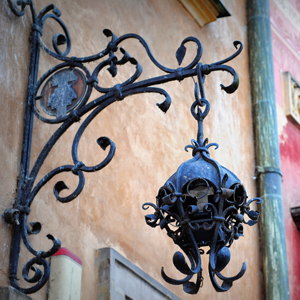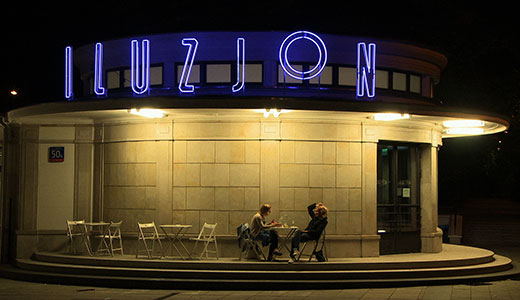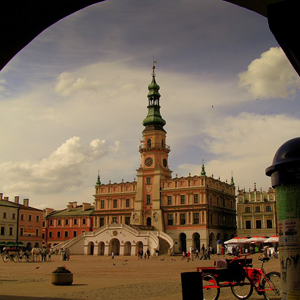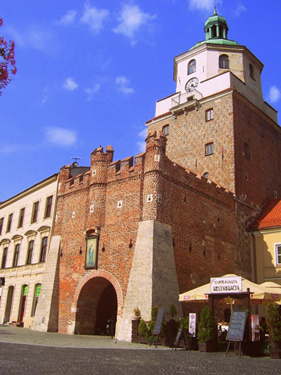
Brama Krakowska, the entrance to the Old Town Square, and the entrance to a wealth of cafés and restaurants.
If you pass through enough archways, and turn enough corners, leaving the bustle of Lublin’s curving streets, you enter a gardened courtyard between colorfully plastered townhouses. At night, young couples gather there, acknowledging each other enough to show that they have come for the same purpose, and turn back away into a huddle and look out over the fields beyond the city, dimly lit by a single lamp post. Sometimes a tune plays quietly from somewhere, but it is mostly silent here. Someone always lights a cigarette, lending a match to the next couple over. The whole space becomes filled with a sense of timidity and desire that only those who are there will recognize. Lublin is filled with these hidden spaces, setting a delicate scene for authentic passion and unbridled romance.

Lublin’s square – the very heart of the Old Town – lined with dozens of open cafés and restaurants, is always buzzing with life.
While the city may seem small at first, it seems to grow larger at every turn as the castle comes into view, church tops peek through, and more side streets appear. People emerge from little shops and underground bars as students run off to class and babcie head home from the targ wealthy with fresh vegetables. The renowned intricate baroque facades along the winding streets of the old town are being coated with fresh paint, while artists transform simple walls turned-canvases into enchanting murals that beckon you down narrow alleys and around hidden corners.
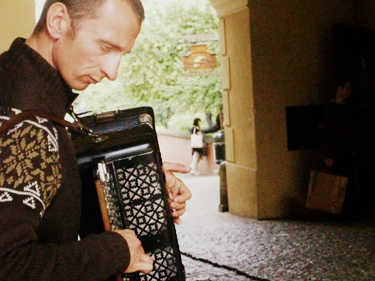
This accordion player, with his intricate and beautiful instrument, would place himself for acoustics rather than traffic. He was absolutely absorbed in his music and stopped only if you interrupted.
Accordion players, violinists, and aspiring singers are scattered throughout the rynek, along Krakówskie Przedmieście, and stand in acoustic archways. All the while, residents and visitors hobble along the cobblestones heading off for an afternoon drink or to any of the dozens of theaters and galleries, stopping along the way to glance at the antique trinkets and old books sold on the sidewalks. The sounds blend into a strange but enticing soundtrack for those strolling slowly, eyeing the irresistibly fancy desserts at Vanilla Café and becoming intoxicated by the smells coming from the utterly mouth-watering Habiby Kebabs. In the garden at GramOFFon, satisfied diners are filling themselves with pizza and pierogi, while others sit on the old stone foundations of a church in Plac po farze, indulging in ice cream and fresh gofry.
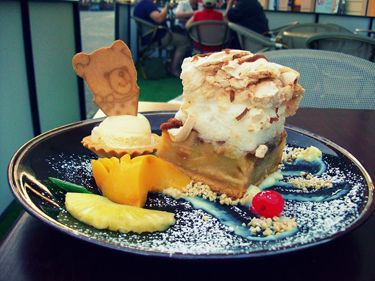
A tasty “szarlotka” dessert at Vanilla Café – always with a flair for aesthetics.
I cannot count the number of small cafés that dot the city. Every restaurant seems a space more for observation than for sustenance. These feel like the places of a century prior, where writers like Bolesław Prus and Józef Czechowicz huddled in the corner, gathering inspiration from watching the lovers by the windows, or listening to regulars share stories of a time long gone. At Opium Café, by the University Park, students will sit well into the morning hours, sharing beer and tea, curling up in the well-worn armchairs and couches. Closer to the center of town, cafes like the chic and artsy Kap Kap Café on Narutowicza signal the rapid westernization of the city – and the incoming “Warsaw prices.”
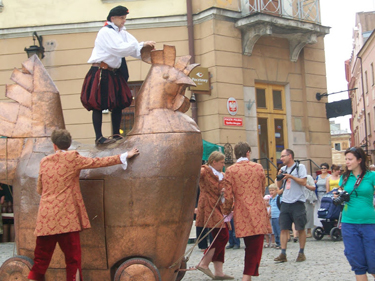
The Jarmark festival spokesman and his assistants make their way through old town, calling visitors to different events of the day.
It seems every weekend a remarkable crowd of tourists, locals, and performers fill the streets with no limit to the curiosities that emerge. I am no longer surprised to see a tight-rope walker crossing between the open windows of the Old Town buildings, or a man on a giant rooster pushed through the streets by men dressed in renaissance garb while a crowd gathers around a kiełbasa stand across from the Brama Krakówska. It is really no wonder that the city boasts the title “Capital of Festivals,” seeing as almost every other weekend a new festival or celebration fills the streets with vibrant colors and unusual sounds.

Graffiti artists work on decorating a bus during a festival promoting local transportation.
In the peak of summer, the Inne brzmienia Art’n’Music Festiwal brings artists, bands, and DJs from around the world. They flood the streets and clubs of Lublin to share their art. Over the five-day period, every minute is filled with sights and sounds that leave the entire city buzzing with excitement. At night, a large part of the rynek is cordoned off for main-stage performances that pack the space from wall to wall with anxious viewers bumping and squeezing to get closer to the stage. Smaller nearby clubs fill with younger crowds, dancing, sweating until the early hours of the morning. They have no intentions of returning home before sunrise, much like any night, really.
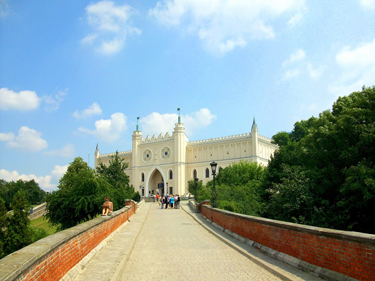
Lublin Castle, now a museum. To the right of the pathway is the location of the former Jewish district and ghetto.
Any given evening in one of the underground bars, you find yourself ducking into a cave-like space, winding through archways into dimly lit nooks with your hands tracing along the stone walls. The Irish Pubs are crowded with homesick international students, while Czeska Piwnica pleasures those same students with the best plates of French fries, fried mozzarella, and cold drinks. Perhaps my favorite spot, however, is that little hole in the wall that leaves only one decision to be made: whether your beer is large or small.
Just outside of town, there is a decent sized lake, surrounded by patches of woods and open fields. Families and friends spread themselves out to picnic and relax in the sun, taking the time to simply breathe. Time seems to stop here away from the world, and life seems simple. But one must always go home to the city, and upon returning, the city’s history always seems to be the first thing to reappear.
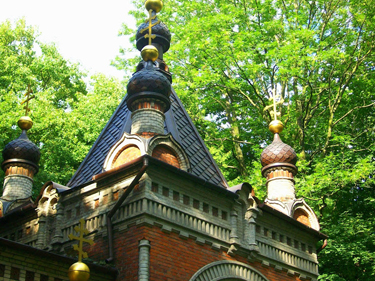
The domes of a small place of worship within one of the largest cemeteries in the center of Lublin.
Lublin’s centuries-old Orthodox and Catholic churches, scattered throughout the city, are a reflection of the rich, multi-cultural, and multi-religious population. Unexpectedly hiding behind high walls throughout the city, one could easily get lost in the thousands of acres of mysterious cemeteries, enraptured by the poetic and magnificent headstones and their adornments. There is an old Jewish Cemetery, a ten-minute walk from where the Jewish quarter, razed by the war, used to stand. In order to enter you have to track down the gatekeeper. If you make it even as far as the cemetery walls, you can peek over to see the headstones, overgrown and strewn with wild daisies. Something about its wild nature suits the land and its purpose, forgotten and left in the past, but open to those who make an effort to remember and see.
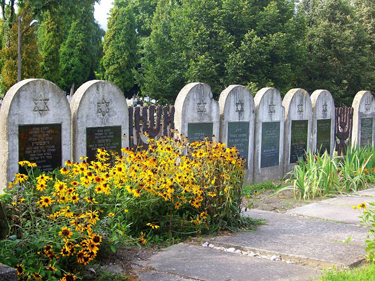
The view over the walls of the Jewish cemetery. These stones line the entire space, with daisies and tulips filling the spaces in between.
For centuries Lublin was home to a large and vibrant Jewish community. The remnants of this history are still felt in the city’s eastern neighborhoods, the land on which the community built their own flourishing and highly respected Yeshiva, a renowned center of Talmudic scholarship recognized throughout the world. However, the German occupation during the Second World War brought with it the Nazi genocidal policy resulting in the near total destruction of the community, and razing the former Jewish district, marked today by a single lamppost that remains lit at every moment of every day. The former ghetto site is now a serene field nestled between the castle and old town. Occasionally giant photos of former Jewish inhabitants will find their way posted onto boarded windows of nearby townhouses in remembrance and commemoration. The chilling museum and monolithic stone memorial at the Majdanek death camp, a six-minute drive from the city center, are further reminders of and testament to the dynamic community that once thrived in Lublin.
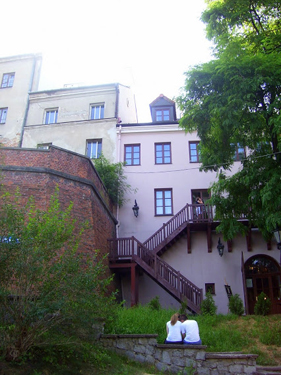
A couple huddles together on a back street of Lublin.
Not only is Lublin a city of inspiration, it is also a town of serendipity. It is impossible to pass through the city’s gates without making a friend or leaving without a story to tell. The winding streets of the city never seem to end, as layer upon layer of the city is revealed. Photographers and urban explorers visit Lublin, not so much for the picturesque views, but for the love, history, character, and emotion that seems to fill their lenses by some inexplicable magic. Perhaps the sensations become one with the light that seeps through the aperture.
I have lived and studied in Lublin twice, now, but visit every chance I can. I fondly recall walking down the golden, former-monastery halls of the Catholic University, warmed and brightly lit by the sunlight streaming in through the grand, arched windows. I often miss the authenticity of the city, one that I cannot find in the tourist centers of Poland. In Lublin, I became inspired, encouraged to push beyond my own boundaries, able to embrace and experience absolutely everything with every ounce of my being. Just thinking about the city pulls at my heartstrings, filling me to the fingertips with swells of emotion.
CR
VIEW a slideshow with more of Lara’s photographs of her beloved Lublin:
